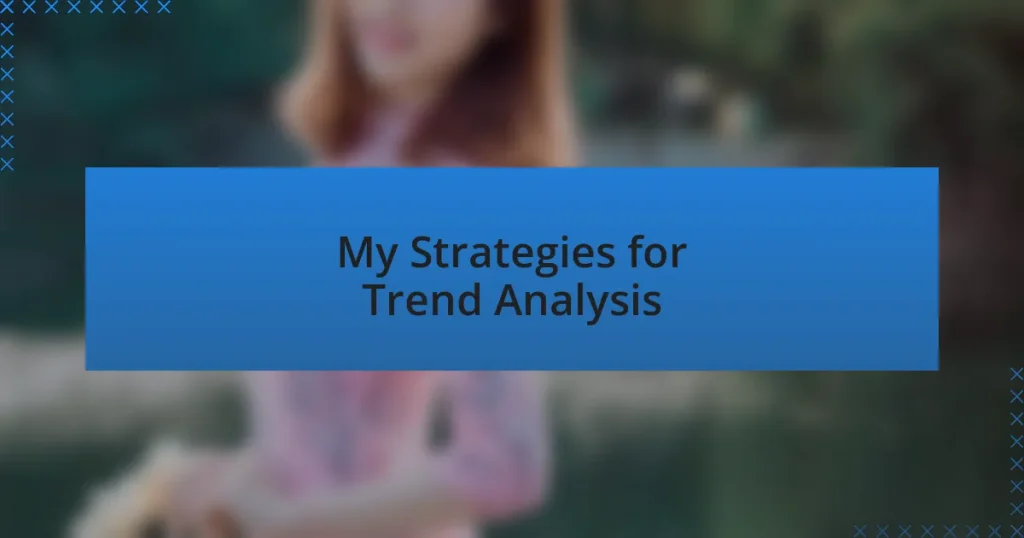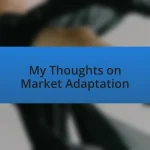Key takeaways:
- Trend analysis helps uncover societal values and consumer preferences, providing insights to navigate the fashion landscape effectively.
- Utilizing tools like social media analytics and Google Trends can enhance the ability to predict and adapt to emerging fashion trends.
- Emerging trends can be identified through street style observation, designer collections, and engagement with influencers and fashion blogs.
- Successful trend implementation requires authenticity, small-scale testing, and consistent engagement with the audience.
Author: Charlotte Hawthorne
Bio: Charlotte Hawthorne is an acclaimed author known for her compelling storytelling and richly drawn characters. With a passion for exploring the complexities of human relationships, her novels often blend elements of romance, intrigue, and self-discovery. A graduate of the University of California, Charlotte has received multiple awards for her work, including the prestigious Silver Quill Award. When she’s not writing, she enjoys hiking in the Sierra Nevada mountains and sipping coffee at local cafes. Charlotte currently resides in San Francisco with her rescue dog, Jasper.
Understanding trend analysis
Trend analysis is about more than just tracking what’s popular; it’s about understanding the forces that shape these trends. I still remember the excitement of spotting a particular fabric gaining traction in the market, realizing how it echoed broader cultural shifts. Isn’t it fascinating how a single trend can reflect changes in societal values or environmental consciousness?
I often think about how trends can create a visceral connection between individuals and the world around them. For instance, the rise of sustainable fashion wasn’t just a trend for me; it became a personal mission. Have you ever felt compelled to adapt your wardrobe to reflect your values? That’s the essence of trend analysis—it’s a mirror to our desires and struggles.
When diving into trend analysis, I find it helpful to look for patterns over time, allowing me to anticipate shifts before they explode into mainstream consciousness. What if you could predict the next big thing in fashion simply by observing micro-trends emerging on social media? By engaging with these subtle cues, I’ve often found myself ahead of the curve, transforming not only my style but also how I approach the industry as a whole.
Importance of trend analysis
Trend analysis serves as a compass in the fashion landscape, helping us navigate the complex terrain of consumer preferences. I remember a time when I anticipated a shift toward retro styles because of social media influencers suddenly embracing vintage pieces. This foresight allowed me to curate my wardrobe strategically, aligning it with what was about to resonate with my peers.
By grasping the nuances of trend analysis, we equip ourselves with the insights needed to make informed decisions. I often think back to my early days of experimenting with changing styles; understanding trends helped me avoid the pitfalls of fleeting fads that faded quickly. It’s like holding a treasure map that reveals not just where to dig, but also which gold is worth the investment.
Moreover, trend analysis is essential for building brand loyalty and connection. When I see brands that resonate with me, it’s often because they’ve tapped into authentic trends that reflect my aspirations. Have you ever felt drawn to a label, not just for their designs but for how they align with the world’s evolving narratives? Recognizing these trends allows us to engage deeply with fashion, turning it into a vibrant dialogue rather than a superficial transaction.
Key tools for trend analysis
When it comes to trend analysis, having the right tools can make all the difference. I rely heavily on social media analytics platforms to track emerging patterns and understand what captures people’s imaginations. For instance, I once used Instagram insights to pinpoint which styles were going viral, leading me to incorporate those trends into my outfits before they hit mainstream popularity.
Another essential tool is Google Trends, which offers a fascinating glimpse into what consumers are actively searching for. It’s incredible to see how a sudden spike in searches for a certain color or style can signal a shift in the market. There was a time when I noticed an uptick in interest for oversized silhouettes. I quickly adapted my shopping habits, and soon after, those very pieces became staples in my wardrobe as the trend unfolded.
Lastly, engaging with online fashion communities and forums has proven invaluable. These spaces are brimming with discussions about upcoming trends and personal style journeys. I remember joining a forum focused on sustainable fashion, where members dissected trends like eco-friendly materials. This exchange not only deepened my understanding but also fostered connections with like-minded individuals, enhancing my own style journey while keeping me informed about what’s next in fashion.
Identifying fashion trends effectively
When identifying fashion trends effectively, I often find myself observing street style as a primary source of inspiration. Walking through different neighborhoods, I can’t help but notice how diverse styles emerge in various locales; that first glimpse of someone sporting an unconventional mix of patterns can spark ideas for a fresh look. Have you ever spotted a trend before it hit the runway? It’s thrilling to see how grassroots fashion influences designers.
I also pay attention to seasonal shifts in collections from both large and emerging designers. There was a time when I watched a collection debut at New York Fashion Week that featured bold prints reminiscent of the 70s. It struck me how quickly these styles started appearing in fast-fashion stores afterward. Recognizing such trends early helps me curate my wardrobe thoughtfully—beyond just what’s popular, but what resonates with my personal aesthetic.
Lastly, I find that engaging with fashion blogs and influencers helps me stay ahead of the curve. Once, an influencer I followed highlighted a revival of 90s silhouettes, sparking my interest in thrift shopping for vintage finds. It’s a dynamic way to connect trends with unique pieces while infusing my wardrobe with history and character. Isn’t it exciting how the past can inspire modern fashion choices?
Analyzing trends in lifestyle blogs
Analyzing trends in lifestyle blogs often involves diving into the emotional connections that readers develop with different styles. I remember stumbling upon a cozy home decor blog that showcased minimalist living. The photos of serene spaces filled with light and plants resonated deeply with me, perfectly capturing the desire for tranquility in our chaotic lives. Doesn’t it feel liberating to embrace simplicity in our homes while curating a peaceful retreat?
When I assess blog content, I prioritize the storytelling aspect, as it can reveal the essence of evolving lifestyles. For instance, one time, I read a blog post about sustainable living that illustrated how small changes, like shopping at local farmers’ markets, can create a ripple effect in our communities. It dawned on me how personal experiences within these narratives can shape overall trends—people yearn for authenticity and relatable journeys. Isn’t that what draws us to certain blogs in the first place?
Additionally, the interaction between bloggers and their followers plays a crucial role in trend development. I find that when bloggers actively engage with their audience—responding to comments or asking questions—they create a sense of community. This dynamic exchange not only helps in identifying emerging interests but also cultivates a loyal readership that’s eagerly waiting for the next trend revelation. What trends have you noticed blossoming from these conversations? For me, it’s clear that the heartbeat of lifestyle blogging lies in these personal connections.
Tips for successful trend implementation
When implementing a new trend, it’s vital to remain authentic to your unique voice. I once shadowed a popular lifestyle blogger who effortlessly integrated the trend of sustainable fashion into her posts. Instead of forcing it into her established style, she shared her genuine journey of wardrobe decluttering and thrift shopping, which resonated with her audience. Have you ever noticed how authenticity speaks volumes?
Another effective strategy is to test trends on a small scale before fully committing. I learned this firsthand when I decided to experiment with the monochromatic outfit trend. By showcasing a few simple looks on my blog, I could gauge the response without overcommitting. It was eye-opening to see how my readers reacted—it often led to insightful feedback that guided my future content. What small experiments have you tried that turned into your signature style?
Lastly, consistency is crucial. I remember when I first introduced a weekly style challenge on my blog, encouraging followers to share their interpretations of a trending outfit. This approach not only kept my content fresh but also involved my readers in a fun, interactive way. Have you considered how consistent engagement can enhance your trend implementation? Building a routine around trends can foster a deeper connection with your audience while keeping your content dynamic.


